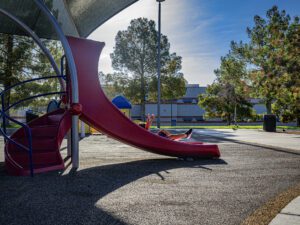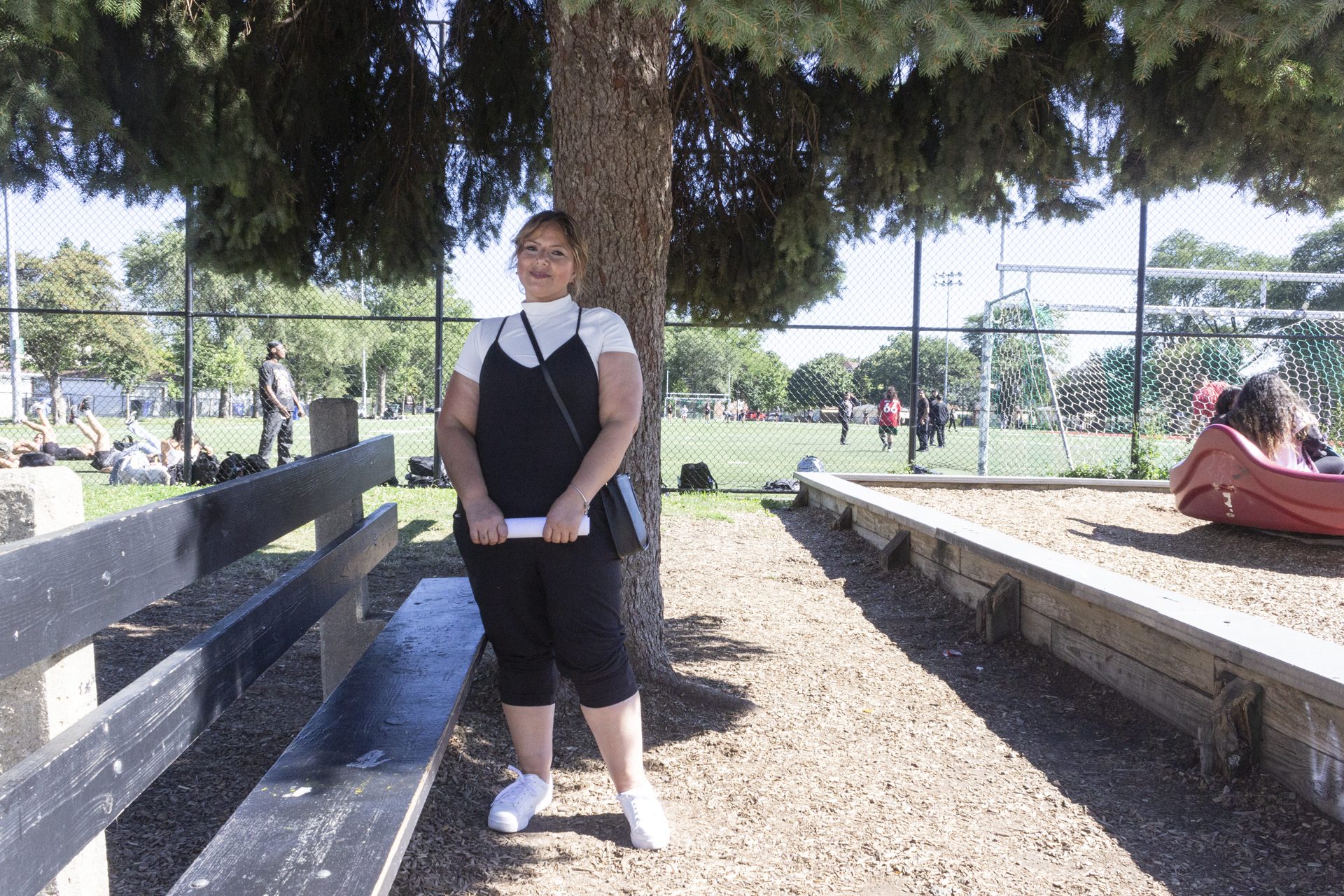 Aydali Campa/Borderless Magazine
Aydali Campa/Borderless MagazineIn majority Latino neighborhoods like Brighton Park on the southwest side, residents have come together to push the city to invest more in parks and neighborhood green spaces in the face of climate change.
This story is part of a collaborative reporting project led by the Institute for Nonprofit News and includes Borderless Magazine, Cicero Independiente and Inside Climate News. It was supported by the Field Foundation and INN.
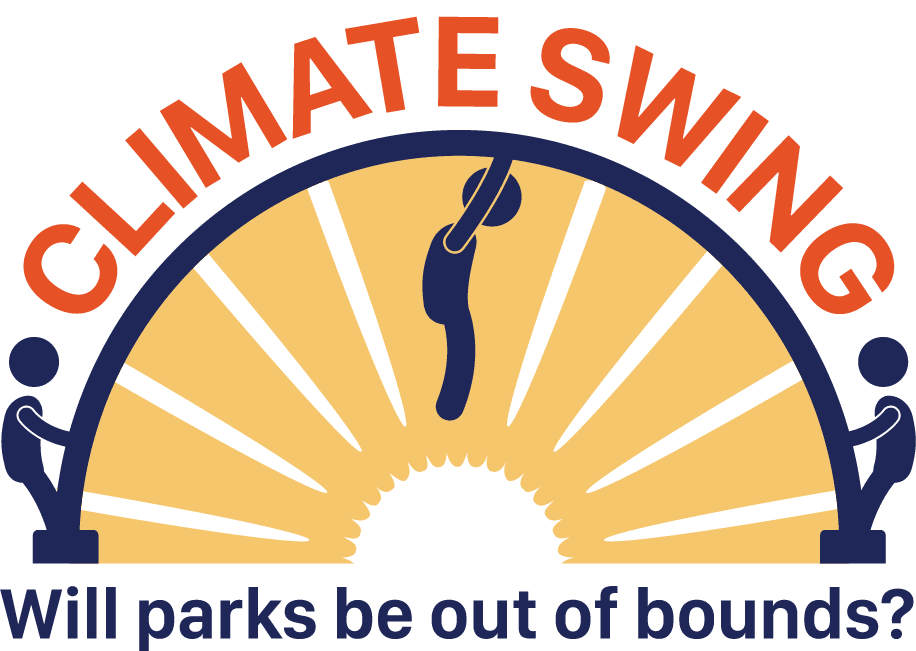
Carmen Barragan remembers the church bells ringing from her village’s plaza in Michoacan, Mexico. She recalls looking out at the bustling courtyard filled with fruit vendors, children playing games and the verdant trees that engulf the plaza in her hometown of Cotija.
That vibrancy is a standard that she hopes to see in outdoor gathering spaces in her neighborhood of Brighton Park on Chicago’s Southwest Side. It led her to become a community organizer focused on promoting health through her neighborhood council.
Her mission: create safe community hubs for her neighbors to use and come together.
But it hasn’t been easy.
Want to receive stories like this in your inbox every week?
Sign up for our free newsletter.


“I would take my kids to parks in other neighborhoods and see that they are in better conditions, and it seems like people there didn’t have to fight for those parks to be maintained, but here we do,” said Barragan.
Her organizing efforts contributed to multi-year campaigns that led to renovations at Kelly Park, a play area known as Hidden Park and a school playground in Burroughs Elementary School.
This organizing is vital for Barragan’s community.
Brighton Park is one of the hottest neighborhoods in Chicago, experiences high levels of air pollution and is susceptible to flooding. Its residents are also among the most physically inactive.
At the same time, it lacks a key element to combat these conditions brought on by climate change: substantial green space and parks.
Barragan was happy when the Chicago Park District announced plans to build its headquarters with a park in her neighborhood. The new facility, which includes indoor and outdoor recreation and nature areas, opened in the neighborhood last year — a significant win for the community known as a park desert.
Still, the Chicago Park District has a long way to go to help Brighton Park and other neighborhoods catch up with other parts of the city with greater green space access.
Research has shown that a lack of access to parks and green spaces isn’t rare for communities with demographics like Brighton Park. The neighborhood comprises mostly low-income residents and a majority Hispanic population.
In a recently published study, researchers examined access and connectivity of green spaces in 10 major cities, including Chicago. The study found that neighborhoods in Chicago with a higher proportion of Hispanic residents are associated with smaller and fewer parks, less vegetation and less connectedness between those spaces than neighborhoods with higher proportions of any other race or ethnicity.
Read More of Our Coverage
The research highlighted that larger and better-connected trees and green areas are essential for helping urban communities respond and recover from the effects of climate change, including more frequent heavy rain events, poor air quality days and extreme heat. Green spaces can lower air temperature, improve air quality and absorb floodwater.
Disparities in green space connectivity can affect the extent of these benefits for nearby communities, according to the new study co-authored by Michelle Stuhlmacher, assistant professor of geography at DePaul University.
Barragan notices daily the difference the study points to in her city. “We need to be more equitable,” she said. “We all deserve the same opportunities as those in the south and north.”
Uneven distribution of green space and parks in Latino communities
Chicago fares pretty well compared to other cities when it comes to average accessibility to parks. Data from the Trust for Public Lands shows that 98% of Chicago’s population lives within close proximity to a park. However, access to parks is not evenly distributed across the city, with Hispanic and Latino neighborhoods having 41% less access to parks than the average Chicagoan.
Stuhlmacher noted that having a park nearby doesn’t necessarily mean access to substantial tree canopy coverage and vegetation.

Her study found that some densely populated and more affluent areas, like Fulton Market and the Near North Side, also have low levels of green space, parks and tree canopy. However, the study identified nearly half of the areas with significantly low clusters of green spaces are in majority-Hispanic neighborhoods like Brighton Park, Belmont Cragin, Pilsen and West Elsdon.
For example, some parts of Chicago, like Lincoln Park, have over 30% tree canopy coverage, while Brighton Park has 12%. The Southwest Side neighborhood is about 80% Hispanic, with more than 40% foreign-born residents.
According to the study, large tree canopy clusters are concentrated in Chicago’s outer edges, on the far North and Far South Sides, due to their lower population density and larger parks. Neighborhoods in the West, Northwest and Southwest Sides with a majority Hispanic population tend to have smaller and less connected patches of green space.
Several of these majority-Hispanic neighborhoods are also communities that were historically redlined. According to the Environmental Protection Agency’s environmental justice mapping and screening tool, they face economic hardship and additional environmental burdens exacerbated by climate change, like higher temperatures, poor air quality and susceptibility to flooding.
In recent years, the city’s investments have reduced this disparity, including building the new park district headquarters in Brighton Park with climate change in mind.
The Chicago Park District did not respond to questions from Borderless Magazine.
Barragan said that sometimes people don’t understand how vital parks and green spaces are in fostering healthier and more connected communities.
A more robust community network, like the one Barragan is fostering, can encourage collaboration and resource-sharing during emergencies, making them better equipped to respond to and recover from climate challenges, said Sara McTarnaghan, a principal research associate at the Urban Institute.
A community campaign for more green space
Barragan moved from Mexico to Brighton Park in 1999. At the time, she was recently married with two children and another on the way. She described culture shock in those early days. She didn’t speak English, felt unsafe, didn’t know anyone in the city and lacked a space in the neighborhood to meet people.
A few years after settling in, she discovered the Brighton Park Neighborhood Council through her children’s school, Burroughs Elementary. She volunteered to fundraise for a community gathering — the first time she felt part of a community since leaving Michoacan.
“I had fallen into a depression, but the feeling of being a part of a community helped me get out of it,” she said.
Over the last decade, she’s organized programs focused on community health for the neighborhood council, including advocating for city investment in parks in the neighborhood.

In 2011, she led efforts to push the city to renovate Kelly Park — the neighborhood’s only park. More than 300 Brighton Park residents gathered in the basement of St. Pancratius Catholic Church to discuss the park’s problems. Residents wanted a place for their kids to relax and play safely. Kelly Park wasn’t cutting it, Barragan said.
Brighton Park Neighborhood Advisory Council members recall Kelly Park’s dilapidated playground, crumbling turf and flooding after rain because of poor drainage.
“It would turn into a swamp after it rained,” said the executive director of the neighborhood council, Patrick Brosnan.
“We basically didn’t have a green space in Brighton Park,” said Sara Reschly, former Kelly Park Advisory Council president.
For community members like Barragan, that meant driving her kids to parks in other neighborhoods to play soccer.
The meetings kicked off a community-wide effort to pressure the city to significantly improve the park. They knocked on doors, held meetings, fundraised, and attended Park District budget meetings. They called out the city’s inequitable distribution of investments in Chicago’s North Side parks, some of which have bountiful vegetation, new fieldhouses, and well-maintained play fields, said Barragan.
A 2011 Chicago Tribune report about the unequal distribution of quality parks in Chicago and the campaign to renovate Kelly Park highlighted Brighton Park as “park poor.”
The neighborhood campaign raised about $2 million and ultimately secured the support of the Chicago Park District to renovate the park. Kelly Park was renovated in 2015, with two added soccer fields, a new playground, refurbished baseball fields, updated drainage, renovated basketball courts, and restored landscaping.
More than a decade later, the Chicago Park District relocated its new headquarters with a sprawling park in the neighborhood last year. According to the Chicago Park District, the location was selected as part of the city’s effort to prioritize investing in communities and the community’s need for more open space.
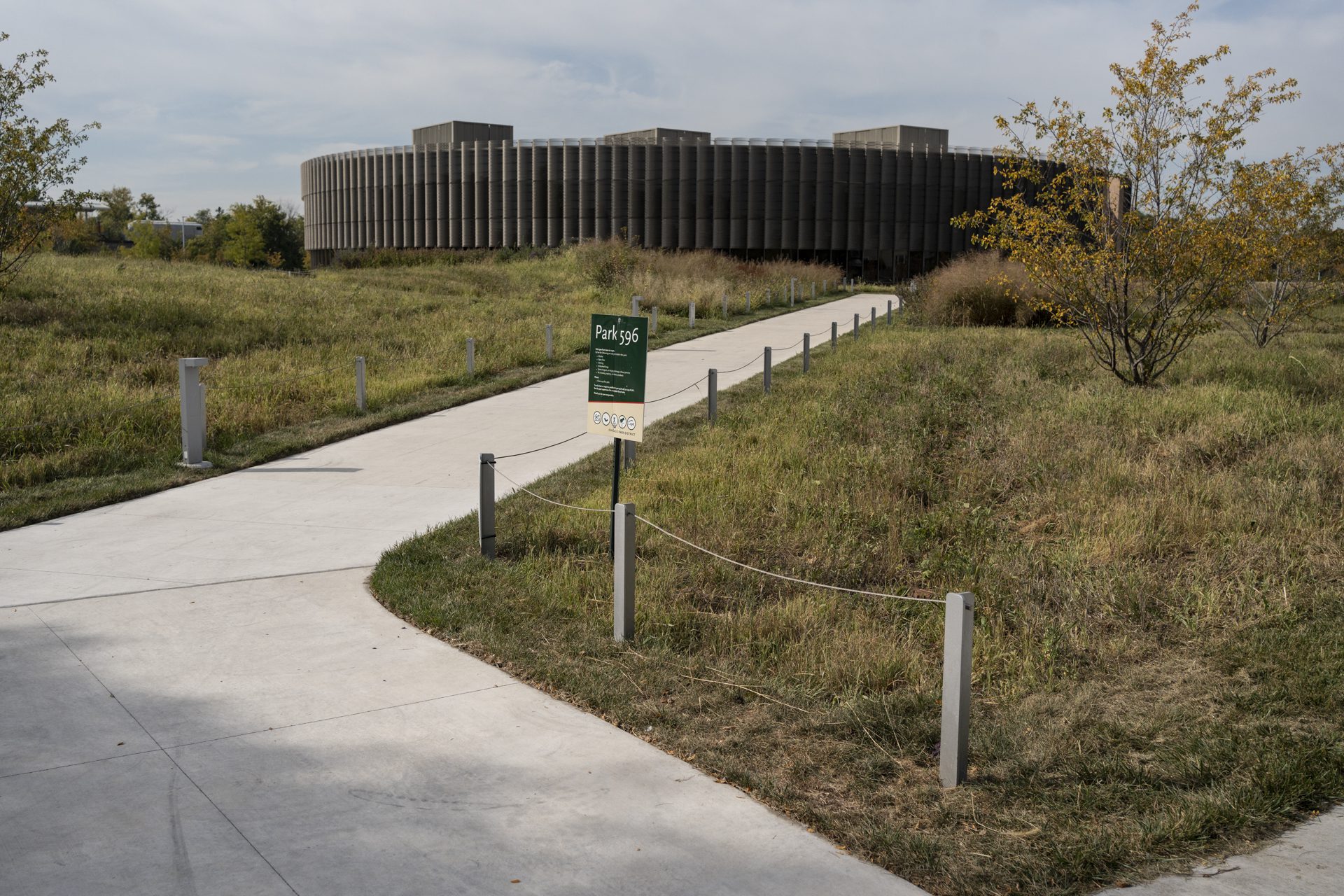
Brighton Park Community Campus spans 17 acres and was built on a vacant lot, formerly home to a number of factories and processing facilities. According to the Chicago Park District, the park was designed to have “minimal impact on the environment,” with an energy-efficient facility for both the park district headquarters and a fieldhouse for public use. It also features native gardens, trees and grasses to absorb stormwater and reduce the effect of urban heat islands.
The new park is also part of a larger effort by the city to address disparities in quality park and green space access, according to the Chicago Park District’s Capital Improvement Plan. In recent years, the city has committed millions of dollars to expand natural areas, create new and improved fieldhouses, build climate-resilient playgrounds and plant 75,000 trees by 2027.
This year, Chicago moved up in rankings from 16th place to 10th when it comes to access to parks among major cities in the U.S., according to an annual analysis by the Trust for Public Land.
Still, Stuhlmacher said that to address the gap in green spaces, the city needs to focus efforts on communities that lack these spaces and face environmental burdens because they need these benefits the most.
She said planting more trees soon and where possible is critical in densely populated neighborhoods with limited space in large vacant lots, like Brighton Park. It takes years for trees to reach the level of growth that provides the most environmental benefits.
Who will look after our parks?
Less than two miles north of Kelly Park, Wence Garcia brings his 8-year-old twin daughters to La Villita Park multiple times a week. They enjoy the playground and run through the splash pad on sweltering days.
If they get there early enough, at around noon, it’s peaceful before the bigger kids arrive.
“I like that it’s very clean,” said Garcia, who often sees people cleaning the park.

The park is in Little Village, another community with a majority Hispanic population and lower levels of green space connectivity. Many years of advocacy led by the Little Village Environmental Justice Organization (LVEJO) resulted in the creation of La Villita Park in 2014.
Many people want more green space, but are concerned about who will pay for maintenance, said Jacqueline Vasquez, a park organizer at LVEJO. Organizers say Park District funds for general maintenance aren’t enough to upkeep parks. Volunteers help with the upkeep in Little Village, while donations have supported adding more trees to the park.
In neighboring Pilsen, Claudia Galeno-Sanchez promotes green spaces and native gardens in the Lower West Side neighborhood. Galeno-Sanchez, a coordinator for Women for Green, has planted gardens in schools, churches and homes throughout Pilsen. Promoting and creating green spaces has also meant finding volunteers to help maintain the gardens.
“Parks are supposed to be public areas for green spaces,” she said. “I feel like there aren’t sufficient trees for the kind of heat we get here.”
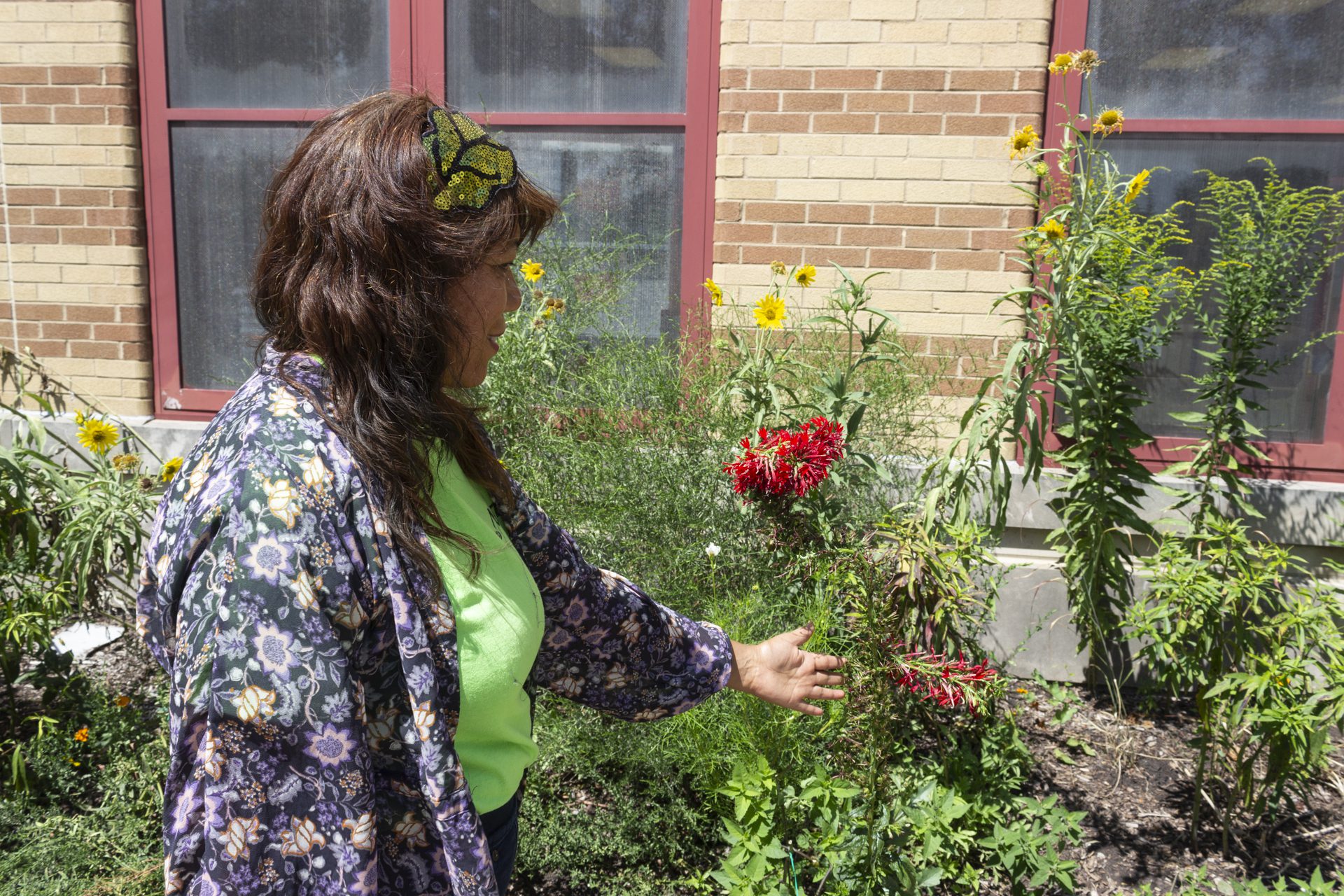
Like Brighton Park, Pilsen is a heat island. These urban areas are significantly warmer due to the built environment, such as buildings, roads and infrastructure that absorb and re-radiate heat more than natural landscapes like forests and bodies of water. That makes the communities’ work advocating and maintaining parks vital in the face of climate change.
Over the years, Barragan has gathered volunteers to clean up parks in Brighton Park. She recalls a campaign she led over a decade ago in which neighbors helped pick up trash and bring their own lawn mowers to trim the grass at Hidden Park — an effort that eventually led to the park’s renovation.
She plans to continue promoting the use of outdoor spaces and other practices for a healthy life.
After almost 20 years of community organizing, Barragan’s grassroots efforts have significantly improved Kelly Park and other community spaces.
“We’ve always had to fight [for these improvements], so it is frustrating, but at the same time, it is very gratifying to see these spaces open,” Barragan said. “It makes us think back on how we got these spaces, how we fought for them and how we came together.”
She feels proud when the space comes alive with families gathering at Kelly Park for games in the afternoons and Friday evenings — a small reminder of the bustling plaza in Cotija.
Aydali Campa is a Report for America corps member and covers environmental justice and immigrant communities for Borderless Magazine. Send her an email at aydali@borderlessmag.org

